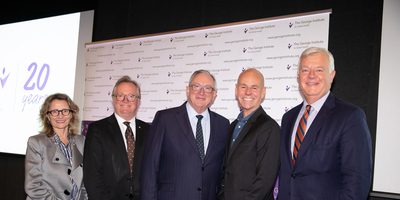
20 years of saving lives
Working with The George Institute for 20 years, critical care physician Professor Simon Finfer has led transformational studies into intensive care to reduce mortality and shed light on one of the world’s most serious silent killers – sepsis.
Now Professorial Fellow in the Critical Care and Trauma Division at The George Institute, Simon first came across the Institute shortly after its establishment in 1999.
“By chance, it had just been set up in an office in one of the old buildings at Royal North Shore Hospital, which is where I worked at the time and still do,” he says. “The Institute only had about eight people then but they were open to really ambitious ideas.”
Simon and others soon designed and found funding for the world’s first intensive care unit (ICU) mega-trial, the SAFE study, which was the first to demonstrate that robust, high-quality research could be done with critically ill patients.
“It really changed the whole landscape of critical care and research around the world because most people believed it was not possible to recruit that number of patients into a critical care trial and make sense of it,” he says. “I think our greatest achievement at the Institute has been to demonstrate that really robust, high-quality research could be done in the critical care population and lead to improved mortality.”
The success of that trial led to numerous other ICU guideline-changing studies until Simon found himself coming full circle to focus on a condition about which he had conducted pioneering research many years earlier as a founding member of the Australian and New Zealand Intensive Care Society (ANZICS) Clinical Trials Group.
“I did the original study of the epidemiology of sepsis in Australia and New Zealand in 2003 and it was quite clear that sepsis was one of the major issues that we needed to tackle in ICUs to reduce mortality rates,” he says.
Sepsis is a life-threatening condition that occurs when the body's response to infection damages internal organs and tissues. If not treated, it can lead to worsening organ failure and death. Many who survive sepsis are left with horrendous life-changing conditions, including amputation and post-traumatic stress disorder.
"Sepsis kills more Australians each year than breast or prostate cancer, but there’s no public outcry about this, or national campaign to reduce the shockingly high death rate,” says Simon. “It is still the most common cause of death in patients in ICUs."
When Simon began his initial study into sepsis, around 100,000 people were being admitted to ICUs in Australia each year, with the average mortality rate at around 15%.
"One in six-to-seven people who went to intensive care would die during their hospital admission,” Simon says. “We set ourselves the goal of reducing that by 2%, which would mean saving 2,000 lives per year – the same number of people killed on the roads in Australia each year."
Simon and his team at the Institute, along with other research teams trialed a number of medical interventions to reduce the mortality rate, which included raising awareness about the disease among hospitals.
The results speak for themselves.
"The mortality rate across the world of patients with sepsis shock 20 years ago was just short of 50%, and now it's in the high 20s,” he explains. “I can confidently say that we collectively achieved the 2% figure quite easily and substantially."
Nevertheless, much more needs to be done and Simon now sees raising awareness of sepsis among medical practitioners and the general public as another key factor to reducing mortality, particularly among vulnerable groups such as children.
“More than 50 percent of sepsis deaths in children occur within 24 hours so it is essential parents are aware of early symptoms and seek urgent medical care,” he says.
“Sepsis can be prevented and, in many cases, can be treated successfully. We need to ensure that when patients present with symptoms they receive the best care possible, and that treatment begins as quickly as possible.”


